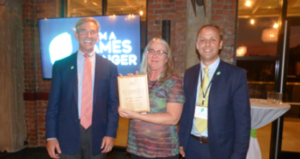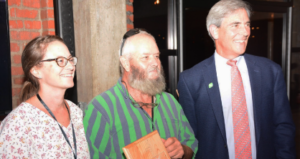The James River Association celebrated it’s 43rd year at our 2019 Annual Meeting and Oyster Roast held in Richmond at The Boathouse at Rockett’s Landing. Members enjoyed panoramic views of the downtown city skyline, an oyster roast, appetizers and cocktails as they mingled with other attendees who shared a passion for the James River. Bill Street, James River Association’s CEO, gave a sneak peek of the 2019 James River State of the James report, which is a report card on the ongoing effort to bring the James River back to full health. This comprehensive assessment of the health of the river is published every two years.
In addition to the State of the James program, we awarded several deserving individuals with our new James Changer Award. These individuals are environmental leaders who have performed honorable actions to protect the James, or connect people to it.
 When Nat Draper, Senior Education Manager, started his work with James River association in 2015, we were educating just above 2,800 public school students, getting them hands on experience out on the James River that year. Since then, we have seen incredible growth. This year, in 2019, we have been able to work with over 11,000 public school students, and this increase has been largely due to allies in our public school systems such as Judy Christopher.
When Nat Draper, Senior Education Manager, started his work with James River association in 2015, we were educating just above 2,800 public school students, getting them hands on experience out on the James River that year. Since then, we have seen incredible growth. This year, in 2019, we have been able to work with over 11,000 public school students, and this increase has been largely due to allies in our public school systems such as Judy Christopher.
Judy has been working as a teacher for 28 years and she has been in Henrico County Public Schools for all 28 of those years. Judy is so passionate about working with students and she has been a relentless supporter for students having hands-on experiences in and outside of the classroom. Three years ago, we started to work with Judy, first with teacher training. We received a grant to train Title I teachers in the east end of Henrico. It was a 3-day training where teachers got to paddle in canoes, conduct water quality on our pontoon boat and collect macroinvertebrates at Pony Pasture.
This year, we again collaborated with Judy to get 8 elementary schools out to our ecology school. JRA is so excited to get these students an experience that will be new and exciting, one that they likely would not have otherwise had the opportunity to have. Besides working extremely hard to get her teachers trained and students to the ecology school, Judy loves to gets students enjoy the outdoors and all that the James has to offer. Thanks for being an advocate for education and a James Changer, Judy!
 From the Allegheny and Blue Ridge Mountains to the Chesapeake Bay, there are more than 250 places to enjoy the James River and its tributaries. These places accommodate a variety of outdoor recreation, not limited to swimming, fishing, paddling, and boating, and last year, visitation to riverside parks exceeded five million. The James River Association is a champion of connecting people to the James and its tributaries and we depend upon partners like John Davy to do our work. In recent decades, few individuals have done more to connect people to the James and its tributaries than John. During his time with the Virginia Department of Conservation and Recreation, John oversaw the planning of state parks including James River and Powhatan.
From the Allegheny and Blue Ridge Mountains to the Chesapeake Bay, there are more than 250 places to enjoy the James River and its tributaries. These places accommodate a variety of outdoor recreation, not limited to swimming, fishing, paddling, and boating, and last year, visitation to riverside parks exceeded five million. The James River Association is a champion of connecting people to the James and its tributaries and we depend upon partners like John Davy to do our work. In recent decades, few individuals have done more to connect people to the James and its tributaries than John. During his time with the Virginia Department of Conservation and Recreation, John oversaw the planning of state parks including James River and Powhatan.
If you’ve recently visited a park along the lower James, there’s a good chance you’ve seen a Captain John Smith Chesapeake National Historic Trail interpretive sign. John is largely responsible for the planning and development of the James River Segment of the Chesapeake Trail. Even in “retirement” he continues to provide valuable guidance to organizations and agencies developing new public access sites. The James River Association recognizes John Davy for connecting people to the James and creating opportunities for them to develop an appreciation for its natural and cultural resources. Thanks for being a James Changer, John!
 Twelve years ago, when Tish left the Florida Everglades and the Hackensack Meadowlands to work at the Virginia Department of Environmental Quality, she received quite the first task, tackling the biennial assessment of chlorophyll in the James River. High chlorophyll levels in the James warn us of potential algal blooms, which can block sunlight, reduce oxygen, or introduce harmful toxins that threaten wildlife.
Twelve years ago, when Tish left the Florida Everglades and the Hackensack Meadowlands to work at the Virginia Department of Environmental Quality, she received quite the first task, tackling the biennial assessment of chlorophyll in the James River. High chlorophyll levels in the James warn us of potential algal blooms, which can block sunlight, reduce oxygen, or introduce harmful toxins that threaten wildlife.
As a transplant to the Commonwealth, Tish “didn’t know the importance of the number crunching she was about to do.” But shortly after digging into the sordid history of algal blooms in the James and seeing the beauty of the river first-hand, she realized the magnitude of the task.
Thanks to Tish’s number-crunching, we now have chlorophyll standards that are backed by the best available science. These standards will not only alert us to the presence of algae, but they will help us set pollution limits that prevent it. That means healthier habitat for native species and safer water for recreation.
It’s been a long process, but the result is a testament to the importance of building consensus among agencies, industries, and conservation groups alike. And Tish has been at the center of that process, explaining the data in a way that builds confidence and trust.
As DEQ’s water quality assessment coordinator and water quality standards scientist, Tish will continue to help develop and implement regulations that protect our rivers and streams. As she describes it, her work “gives her a front row seat at the stage where science meets policy. And she gets to see the vital role that organizations like the James River Association play in making sure DEQ does its job effectively.” Her words, not ours.
You may wonder, as a certified James Changer, how Tish connects with the James outside of work. This Maymont neighbor likes to chill out at Texas Beach and enjoy watching the sun set behind the James from the Nickel Bridge. Thank you for helping us protect those James River sunsets for all to enjoy. And thank you, Tish, for being a James Changer!
 Buffers, also known as streamside forests, are one of the most important things we can restore and protect along the James and its tributaries. These buffers filter pollutants from runoff, stabilize streambanks and reduce bank erosion, reduce impacts of flooding, shade and cool our streams, and provide important wildlife habitat. Farmers and landowners across the James watershed are doing their part to restore buffers, and there is one farmer in particular that the James River Association would like to highlight.
Buffers, also known as streamside forests, are one of the most important things we can restore and protect along the James and its tributaries. These buffers filter pollutants from runoff, stabilize streambanks and reduce bank erosion, reduce impacts of flooding, shade and cool our streams, and provide important wildlife habitat. Farmers and landowners across the James watershed are doing their part to restore buffers, and there is one farmer in particular that the James River Association would like to highlight.
Tony Pullaro has 2 farms in Albemarle County that the James River Association has been able to work with him on. So much of our work is about relationships and working with landowners on achieving their vision. In this case JRA and Tony have been working together for 17 years. Back in 2002, he worked with JRA to restore a buffer along a small creek at Edgemont Farm. In 2018 we worked with him and our partners at Thomas Jefferson Soil and Water Conservation District on fencing cattle out of the streams and restoring forest buffers at both Edgemont and Heritage Farms.
This past June, the James River Association in partnership with Virginia Department of Forestry, launched the James River Buffer Program. JRA’s goal is to restore over 240 acres of buffer over the next 3 years and Tony was one of the first participants.
Tony is one of those salt of the earth people that just…gets it. In his words, “I feel it’s my job to leave this land in better hands than I found it. And that’s what I’m personally trying to accomplish.” Thank you, Tony, for being an ally in this effort, and for being a James Changer!
 Maeve Hall is in her first semester at the University of Richmond, double majoring in Political Science and Leadership Studies with a minor in Environmental Studies. Maeve is a graduate of Monacan High School in Chesterfield VA. During her time at Monacan High School, Maeve was very involved with JRA programs. She participated in the James River Leadership Academy, volunteered to mentor and speak on her experience with current JRLA students, attended overnight programs at our ecology school, and attended several day paddle programs with JRA’s education team.
Maeve Hall is in her first semester at the University of Richmond, double majoring in Political Science and Leadership Studies with a minor in Environmental Studies. Maeve is a graduate of Monacan High School in Chesterfield VA. During her time at Monacan High School, Maeve was very involved with JRA programs. She participated in the James River Leadership Academy, volunteered to mentor and speak on her experience with current JRLA students, attended overnight programs at our ecology school, and attended several day paddle programs with JRA’s education team.
Maeve is a next-generation leader and we all should see her as a role model. Thanks to the work of Maeve, 2 environmental education grants have been secured which help reduce costs that allowed 60 students in Monacan High School’s Ecology Club attend overnight programs to JRA’s Ecology School on Presquile Nation Wildlife Refuge. Maeve has allowed so many students to make more informed decisions on the best ways to protect the James River. Maeve, thank you for being a James Changer!
 Preserving the natural environment is built into the very core of their brand, and Hardwood Park Craft Brewery was the first brewery in Virginia powered entirely by renewable energy, including solar, biomass, and wind. Our partnership with this environmentally conscious and pioneering craft brewery began not long after they opened their doors in 2011. Our work together blossomed as Hardywood unveiled The Great Return IPA, a tribute to the decades of hard work by conservationists to restore the James River as a bounty of vibrant aquatic life, eco-friendly recreational activity, and in Hardywood’s case, fresh brewing water. These efforts have culminated recently with the symbolic return of the endangered Atlantic sturgeon, a prehistoric, yet majestic behemoth of a fish, spotted as far up the James River as the fall line in Richmond.
Preserving the natural environment is built into the very core of their brand, and Hardwood Park Craft Brewery was the first brewery in Virginia powered entirely by renewable energy, including solar, biomass, and wind. Our partnership with this environmentally conscious and pioneering craft brewery began not long after they opened their doors in 2011. Our work together blossomed as Hardywood unveiled The Great Return IPA, a tribute to the decades of hard work by conservationists to restore the James River as a bounty of vibrant aquatic life, eco-friendly recreational activity, and in Hardywood’s case, fresh brewing water. These efforts have culminated recently with the symbolic return of the endangered Atlantic sturgeon, a prehistoric, yet majestic behemoth of a fish, spotted as far up the James River as the fall line in Richmond.
Hardywood has proved their deep commitment to James River conservation, and each barrel of The Great Return brewed and sold gives back to The James River Association, to support their mission to be the guardian of the James River. Thank you, Hardywood, for being a part of The Great Return of the Atlantic sturgeon and supporting our work to ensure that this symbol of the James River’s health continues for generations to come.

